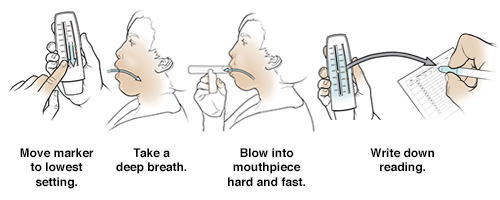A peak flow meter measures how fast you can push air out of your lungs. Your peak flow reading may be an early sign that your asthma is getting out of control. Steps for using a peak flow meter are below. Your healthcare provider may want you to just take peak flow measurements as noted below. Or your provider may want the readings to be part of your Asthma Action Plan.
Name: ____________________
Healthcare provider and phone number: _______________________
I need to measure my peak flow:
-
___ time(s) a day
Check all that apply:
-
______ When I wake up
-
______ At breakfast
-
______ At lunchtime
-
______ In the afternoon
-
______ At dinnertime
-
______ In the evening
-
______ At bedtime
-
______ As needed, when I feel short of breath, have chest tightness, or have wheezing
For instance, your healthcare provider may want you to measure your peak flow 2 times each day, when you wake up and before you go to sleep.
Checking peak flow
Bring your peak flow meter and your record of daily peak flow readings to your office visits. Ask your provider or nurse to check how you use your peak flow meter. They can help make sure you are doing it right. There are several types of peak flow meters. They look different but do the same thing. The instructions below work for all peak flow meters.
Follow these steps to take your peak flow reading:
Step 1
-
Move the marker to 0 or to the lowest number on the scale.
-
Stand upright. No slouching. If you can't stand, sit up straight in a chair. Be sure you're in the same position each time.
Step 2
-
Remove any gum or food in your mouth.
-
Slowly take in a deep breath. Fill your lungs all the way.
-
While holding your breath, put the mouthpiece of the meter between your teeth. Close your lips tightly around it, making a tight seal around the mouthpiece. Check that your tongue does not block the hole.
-
Blow into the mouthpiece once, as hard and fast as you can (1 to 2 seconds). Your peak flow meter will measure how fast you can blow air out.
-
Take the meter out of your mouth.
-
Check where the marker has moved to on the numbered scale. Write this number down.
Step 3
-
Move the marker back to 0. Repeat the above steps 2 more times.
-
Write down the highest of the 3 numbers. This is your peak flow number.
Follow-up with your healthcare provider
As soon as you can, make follow-up appointments as advised.
Call 911
Call
-
Shortness of breath that does not get better after using your quick-relief medicine
-
Trouble walking and talking because of shortness of breath
-
Blue, purple, or gray-colored lips or fingernails
-
Feeling of dizziness or confusion
-
Severe wheezing or problems breathing
-
A peak flow reading less than 50% of your personal best
Featured in


